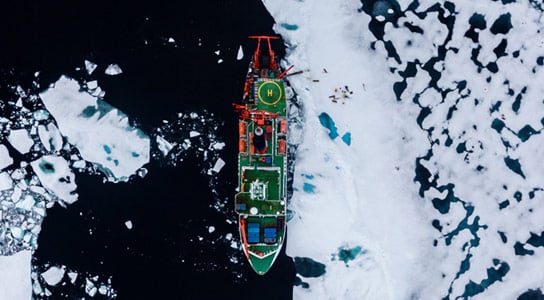
Icy anchorage site: Once the icebreaker Polarstern has dropped anchor at the edge of an Arctic Ice floe, the researchers on board spread out to identify organisms. Credit: AWI
2012 saw the greatest Arctic ice minimum ever recorded, allowing researchers to document the effects of ice retreat and biodiversity in the Arctic deep sea.
The Arctic is one of the habitats undergoing the most radical transformation as a result of climate change. Nobody can predict the effects it will have on biodiversity in the Arctic Ocean. Antje Boetius from the Max Planck Institute for Marine Microbiology in Bremen and the Alfred Wegener Institute for Polar and Marine Research in Bremerhaven traveled with an international team, including scientists from Russia, close to the North Pole, where they documented the effects of ice retreat and biodiversity in the Arctic deep sea.
The Arctic is one of the habitats undergoing the most radical transformation as a result of climate change. Nobody can predict the effects it will have on biodiversity in the Arctic Ocean. Antje Boetius from the Max Planck Institute for Marine Microbiology in Bremen and the Alfred Wegener Institute for Polar and Marine Research in Bremerhaven traveled with an international team, including scientists from Russia, close to the North Pole, where they documented the effects of ice retreat and biodiversity in the Arctic deep sea.
It is three o’clock in the morning and an ice-cold wind is blowing onboard the Polarstern research vessel. It is the end of September. Following weeks of midnight sun around the North Pole at this time, a dense darkness prevails. Given the conditions, there are certainly more pleasant ways of passing the time than sluicing out a load of sludge from the deck.
But Antonina Rogacheva, Elena Rybakova and Renate Degen do not tire of washing nine kilograms of marine sediment through fine sieves when the trawl net brings it on board the Polarstern from a depth of 4,100 meters. Their aim is to coax out even the smallest organisms from this valuable deep-sea sample. Then it’s all hands on deck for cleaning up – the other scientists on the ship don’t appreciate sludge in the objects that they are studying, and the sailors also need to have a fresh workplace.
Despite the effort involved in making the journey, the two-month expedition on the Polarstern provides the three young deep-sea biologists with a unique opportunity to continue working on the “Arctic Ocean Diversity Project.”
The researchers want to decipher the composition of the species living in the Arctic deep sea and find out where the animals derive their energy for life.
For Antje Boetius, who heads up the expedition, the time spent on the largest German research vessel is also a welcome change from her usual working day in the lecture hall and the office. The professor of geomicrobiology at the University of Bremen leads the Joint Research Group for Deep Sea Ecology and Technology, a collaboration between the Bremen-based Max Planck Institute for Marine Microbiology and the Alfred Wegner Institute.
“Before we came along, nobody had ever studied the Arctic deep sea as a habitat in this way. We’ve been on site in the research vessel during the largest ice retreat since satellite records began, and we want to study the consequences. This is something that motivates the entire team,” she says, summing up the attraction of the project.
The 54 researchers come from all over the world, and all are engaged in very different projects. It is Antje Boetius’ job to juggle the various interests. For this reason, a general meeting is held every day – in English, the language used on board for professional purposes. One of the expedition’s objectives is to make an inventory of life in the Arctic deep sea. “Current forecasts predict that all the ice in this region will have melted in 20 years,” says Antje Boetius. Nobody can gauge what such a phenomenon would mean for biodiversity in the deep sea.
The scientists are also studying so-called ice algae. These are perfectly adapted to the solid, yet cold environment of the sea ice in which they grow. Other species can be found in the seawater.
Sufficient sunlight is available only during the few summer months as an energy source for photosynthesis. Various crustaceans, which need to store a lot of energy in order to lay eggs, are among the organisms that rely on this nutritional boost. Therefore, if the algal bloom suddenly occurred a lot earlier or didn’t happen at all, the implications would be disastrous. The deep-sea inhabitants would have nothing else to eat, as they rely on sinking down of the dead algal blooms as an important food source.
In order to study the relationship between the algae, ice, and deep-sea life, the researchers are using a new method for observing marine fauna: the icebreaker Polarstern first cuts a channel in the ice and then turns into a circle. At the spot where the ice channel begins, the researchers lower their trawl net over 4,000 meters (13,000 feet) to the ocean bed to collect the organisms living there and bring them on board.
US deep-sea researcher Alexander Agassiz was the first to come up with the idea of using a type of fishing net for research purposes. Using the so-called Agassiz trawl, the scientist reported on his initial findings as early as 1888; since then, his method has proven itself time after time – although the ice in the Arctic Ocean presents a challenge when it comes to obtaining good samples. The scientists have also placed measuring stations equipped with microsensors on the ocean floor of the Arctic, which they use to record bacterial respiration.
In addition to this, Antje Boetius’ Group also relies on state-of-the-art optics. Her working group at the Alfred Wegener Institute has an extremely powerful piece of equipment, the Ocean Floor Observation System (OFOS). This device consists of a solid, stainless steel frame and a hydraulic cylinder that protects a sensitive interior consisting of a high-resolution, digital SLR camera, high-performance flashes, orientation lasers, and transponders, which continuously report the camera’s position to the scientists. This system enables deep sea researchers to see more than 5,000 meters (16,400 feet) below sea level.
“The OFOS was upgraded before our trip and now takes fantastic pictures of the deep-sea animals in their habitat,” says Antje Boetius enthusiastically. “We are often asked why we still use the ancient Agassiz trawl rather than simply using modern imaging methods to find the deep-sea animals on the ocean bed. But even though the images are very valuable, in identifying large animals for example, a photograph on its own isn’t enough to distinguish between the many species.” Some organisms simply look too much alike.
The scientists from the Shirshov Institute, the Alfred Wegener Institute, and the Max Planck Institute therefore also collect many samples of organisms and their DNA. In their laboratories, they use a combination of traditional and modern methods, namely taxonomic identification based on morphological features. This involves assigning the found items to the correct class, order, family, and genus using an identification key.
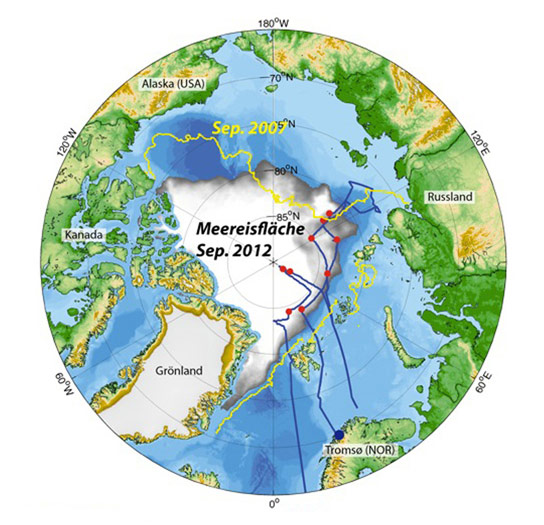
In 2012, the voyage of Polarstern led from Tromsø in Norway 12,000 kilometers through Arctic waters and finally back to Bremerhaven. The chart shows the extension of the sea ice (in white gray) in September 2012: only 3.41 million square kilometers were still covered in ice – the smallest value since the beginning of satellite records in 1973. The smallest sea ice cover of 2007 in circled in yellow. AWI
“The question of ‘who lives where’ is still of great scientific importance. Here in Germany, we have very few taxonomists in our universities. And because their knowledge is not passed on to young biology students, it is gradually becoming lost,” laments the marine researcher. However, when scientists have to identify new species and understand their role in the ecosystem, observations in the habitat, molecular keys and taxonomic expertise must be combined. “We can make the most progress, of course, when we integrate the old and new methods. By doing this, we can reveal outwardly similar individuals as members of different species, for example, which may appear at different times or use other food sources,” explains Boetius.
The scientists recently published their initial results about the energy source for life in the ice-covered deep sea – Antje Boetius and her colleagues actually wrote the article for the journal Science while they were onboard the ship. They were able to observe how large quantities of ice algae melted out of the ice during the productive summer season and sank to the bottom of the deep sea – the ocean floor near the North Pole was almost green with clumps of algae. The researchers don’t yet know if they are observing a unique phenomenon or if they have documented the first signs of a new, more productive Arctic characterized by thin sea ice. Even months after the end of the Polarstern expedition, the scientists are still in the middle of their analysis.
“But now at least we can name the groups of animals that account for the most biomass in the Arctic deep sea,” says Antje Boetius. “These include echinoderms, such as sea cucumbers and feather stars, but also sponges, amphipods, and sea spiders.” Deep-sea fish, on the other hand, are very rare in the Central Arctic Basin. How many species in total inhabit the Arctic deep sea and how many of these are endemic, in other words, are not found anywhere else in the world, are questions that no one has yet dared to ask.
“For example, if we find a starfish in the Arctic deep sea, but we don’t know of any other related species, we can’t rule out that one exists – maybe we just haven‘t discovered it yet. After all, not even one percent of the deep sea floor has been explored.” The biodiversity of the Arctic Ocean therefore can’t be exhaustively documented; the Arctic deep sea is simply too large to do this. Nevertheless, the scientists want to at least describe the basic features of the current biological diversity in this habitat. Future investigations can build on this information and detect any changes that occur.
The Arctic is not the only location where scientists are conducting an inventory of marine diversity. The Arctic Ocean Diversity Project began life in the year 2000 as one of a total of 18 smaller studies that together made up the Census of Marine Life Project.
The Census project was originally intended to last ten years and was funded by a private foundation and various national subsidies. Between 2000 and 2010, approximately 2,700 scientists from 80 countries conducted a census of the seas and oceans. The researchers recorded their observations on the diversity, distribution, and abundance of marine life in biogeographical databases. Some of the participants saw the initial results as an incentive to continue the work independently once the official project period had come to an end. These include the scientists working with Andrey Gebruk at the P.P. Shirshov Institute of Oceanology in Moscow, the two Bremen-based institutes, the University of Fairbanks in Alaska, and the University of Tromsø in Norway.
Researchers from these various institutes formed a loose alliance and used their own funding to continue the Arctic Ocean Diversity Project. The international character of the partnership benefits all participants. “We had a fantastic working relationship with the Russian biologists in particular,” says Antje Boetius. “We had really great colleagues onboard with us and we look forward to analyzing the samples together. There are still too few scientists working on the pressing issue of the Arctic’s future, including its biodiversity, and we urgently need the expertise of zoologists from Moscow, St. Petersburg, and other institutes.”
Reference: “Export of Algal Biomass from the Melting Arctic Sea Ice” by Antje Boetius, Sebastian Albrecht, Karel Bakker, Christina Bienhold, Janine Felden, Mar Fernández-Méndez, Stefan Hendricks, Christian Katlein, Catherine Lalande, Thomas Krumpen, Marcel Nicolaus, Ilka Peeken, Benjamin Rabe, Antonina Rogacheva, Elena Rybakova, Raquel Somavilla, Frank Wenzhöfer and RV Polarstern ARK27-3-Shipboard Science Party, 14 February 2013, Science.
DOI: 10.1126/science.1231346

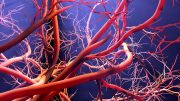
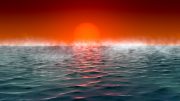

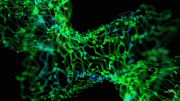

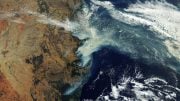

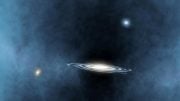
Be the first to comment on "The Effects of Ice Retreat and Biodiversity in the Arctic Deep Sea"